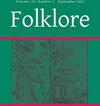Joost Halbertsma’s 1872 Lexicon Frisicum and the Relationship between Men and Women in Nineteenth-Century Friesland
IF 0.2
4区 社会学
0 FOLKLORE
引用次数: 0
Abstract
Abstract This article deals with the relationship between men and women as expressed in the Frisian–Latin Lexicon Frisicum (1872), compiled by Joost Hiddes Halbertsma (1789–1869). The article begins with a brief outline of the Frisian language, then introduces Halbertsma and his dictionary. The main part of the article tries to draw a picture of the relationship between men and women in nineteenth-century Friesland from sample sentences in the dictionary. As expected, we clearly recognize a male-dominated society, reflecting the social division of roles. Taking a broader view, the image that emerges from the various examples is often not as specifically Frisian as one might think at first glance. Although a dictionary can provide a time- and place-bound picture of gender relationships, we must be careful about drawing firm conclusions about the ideological and moral biases of the Lexicon Frisicum and its author. What makes such conclusions even more difficult is that the dictionary was not aimed at ordinary Frisians.1872年Joost Halbertsma的《弗里斯兰词典》与19世纪弗里斯兰的男女关系
本文探讨了Joost Hiddes Halbertsma(1789-1869)编著的《弗里斯兰-拉丁词典》(1872)中所表达的男女关系。文章首先简要介绍了弗里斯兰语,然后介绍了哈尔伯茨玛和他的字典。文章的主要部分试图从词典中的例句中描绘出19世纪弗里斯兰的男女关系。不出所料,我们清楚地认识到一个男性主导的社会,反映了社会角色的划分。从更广泛的角度来看,从各种例子中出现的形象往往不像人们乍一看所认为的那样具有弗里西亚特色。尽管一本词典可以提供一幅受时间和地点限制的两性关系图景,但我们必须小心谨慎,不要对《弗里西姆词典》及其作者的意识形态和道德偏见做出明确的结论。使这样的结论更加困难的是,这本词典的目标读者不是普通的弗里斯兰人。
本文章由计算机程序翻译,如有差异,请以英文原文为准。
求助全文
约1分钟内获得全文
求助全文
来源期刊

FOLKLORE
FOLKLORE-
CiteScore
0.60
自引率
25.00%
发文量
0
期刊介绍:
A fully peer-reviewed international journal of folklore and folkloristics. Folklore is one of the earliest journals in the field of folkloristics, first published as The Folk-Lore Record in 1878. Folklore publishes ethnographical and analytical essays on vernacular culture worldwide, specializing in traditional narrative, language, music, song, dance, drama, foodways, medicine, arts and crafts, popular religion, and belief. It reviews current studies in a wide range of adjacent disciplines including anthropology, cultural studies, ethnology, history, literature, and religion. Folklore prides itself on its special mix of reviews, analysis, ethnography, and debate; its combination of European and North American approaches to the study of folklore; and its coverage not only of the materials and processes of folklore, but also of the history, methods, and theory of folkloristics. Folklore aims to be lively, informative and accessible, while maintaining high standards of scholarship.
 求助内容:
求助内容: 应助结果提醒方式:
应助结果提醒方式:


